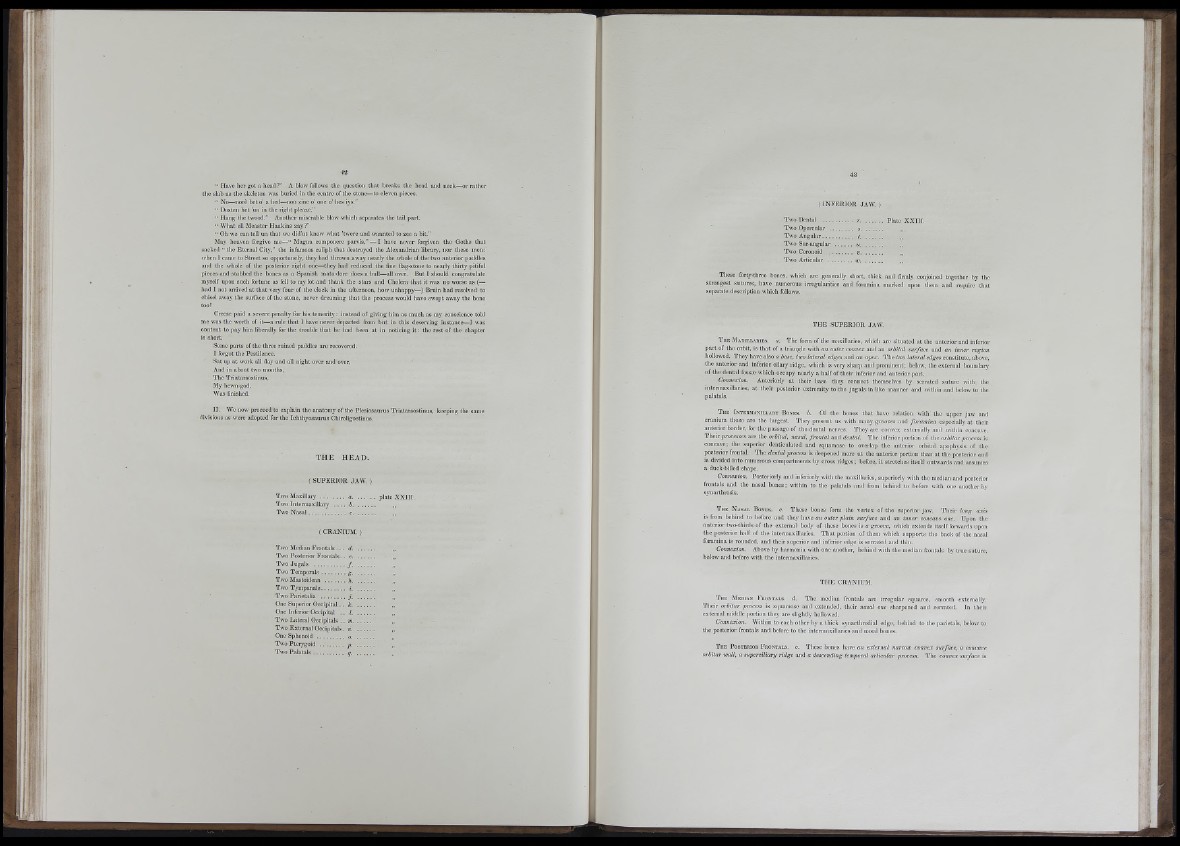
%
f
' i
4 ¿
“ Have her got a licad ?” A blow follows the question tliat breaks the hca<l and neck—or rather
(lie slab as the skeleton was buri«! in the centre of the stone—to eleven pieces.
“ No—«orò bet o' a hed—noo zine o’ one o’ lies iys.”
“ Dosten het 'un in the right plcaze.”
“ Hang the twood.” Another miserable blow which separates tlio tail part.
“ What cll Measter Haakins zay?”
“ Oil we can tell un tliat we did’nt know what ’twcro and waanted to zee a bit.”
May heaven forgive me—“ Magna coniponerc parvis,”— I have never forgiven the Goths that
sacked “ tlic Eternal City.” tlie infamous caliph tliat destroyed the Alexandrian library, nor those men ;
wlion I came to Street so opportunely, they had thrown away nearly tho whole of the two anterior paddles
and tlic wliolc of tlic posterior i-ight one—they had reduced tlie fine flag-stone to nearly thirty pitiful
pieces and stabbed the bones as a Spanish mata-dorc does a bull—all over. But I should congratulate
myself u]>on such fortune as fell to my lot and thank the stars and Cholera that it was no worse as (—
liad I not arrived at tliat very four of tho clock in the afternoon, how unhappy—) Bruin had resolved to
chisel away the surface of the stone, never dreaming that the process would have swept away tlie bone
too!
Crccsc paid a severe penalty for his temerity : instead of giving him as much as my conscience told
me was the worth of it—a rule that I have never departed from but in this deserving instance—I ivas
content lo pay him liberaily for the trouble that he had been at in noticing it ; the fcst of the chapter
is sliort.
Some parts of tlio three ruined paddles are rccoverod.
I foi^ot the Pestilence.
Sat up at work all day and all night over and over.
And ill about two montlis,
Tlic Triatarsostinus,
My liewn-god,
Was finished.
II, Wen
divisions as wci
w procced'to explain the anatomy of the Plesiosaurus Triatarsostinus, keeping the s.
I adopted for the Iclithyosaurus Chiroligostinus.
TH E H EA D.
( SUPERIOR JAW. )
Two Maxillary . . . .
Two Intermaxillary
Two N a sa l...............
.. plate XXIII.
( CRANIUM. )
Two Median Frontals. . . d. ..
Two Posterior Fronlals.. e. ..
Two Jugals / ..
Two Temporals g. ..
Two Mastoidean A, ..
Two Tympanals i. ..
Two Parietalia j . ,,
One Superior Occipital. . k. ..
One Inferior Occipital I. ..
Two Lateral Occipitals .. hi, ,.
Two External Occipitals. n. ..
One Sphenoid o. ..
Two Pterygoid p. ,,
Two P alatals................... ,
-S ri* » « '.« ® » « » » -.'.-. vrnrnsitmidy'drsmiimmii’A
( INFERIOR JAW .)
Two Dental Plate XXIH.
Two Opercular ............... s..............
Two Angular................... t...............
Two Sur-angular ........... u..............
Two Coronoid ............ v ............... „
Two Articular .................w...............
Those forty-three bones, wliich are generally short, thick and firmly conjoined together by tlic
strongest sutures, have luimorous irregularities and foramina marked upon lliem and reijuire that
separate description which follows.
THE SUPERIOR JAW.
Tup. M.vxillaries. ir. The form of the maxillaries, wliich arc situated at tho anlorior and inferior
part of tho orbit, is that of a triangle with an outer eonve.T and an orbital sa/face and an inner region
hollowed. They have also a base, two lateral edges and an apex. The two lateral edges constitute, above,
the anterior and inferior cilary ridge, wliich is very sharp and prominent; below, the external boundary
of llio dental fossae which occupy nearly a half of their inferior and anterior part.
Connexion. Anteriorly at lhcir base they connect themselves by sen-atcd suture with llio
intermaxillaries, at their posterior extremity to the jugals in like manner and within and below to the
palatals.
T he INTEa^fAXILLA^Y Bones, b. Of the bones that have relation with the upper jaw and
cranium these arc tlic largest. Tliey present us with many grotmcs and foramina especially at (licir
anterior border, for the passage of the dental nerves. They arc convex externally and within concave.
Tlicir procc.vses are tlie orbital, nasal, frontal and dental. The inferior portion of the orbilar process is
concave; tho superior denticulated and squamose to overlap the anterior orbital apophysis of the
posterior frontal, Tlie dental process is deepened more at tlie anterior portion tlian at the posterior and
is divided into numerous compartments by cross ridges; before, it stretches itself outwards and assumes
a duck-billed shape.
Connexion. Posteriorly and inferiorly with the maxillaries, sii|)oriorly willi the median and posterior
frontals and the nasal bones; within to the palatals and from behind to before with one another by
synarthrosis.
T he N asal Bones, c. These bones form the vertex of the superior jaw. Their long axis
is from behind to before and they liavo an outer plain surface and an inner concave one. Upon tlic
anterior two-tliiivls of the external body of those bones is a groove, which extends itself forwards upon
the posterior half of the intermaxillaries. That portion of tliom wliicli supports the back of the nasal
foramina is rounded, and their superior and inferior edge is serrated and thin.
Connexion. Above by liarmonia with one anotlier, bcliind with tlic median frontals by true suture,
bolow and before with the intermaxillaries.
THE CRANIUM.
T he Median F rontals. d. The median frontals are irregular squares, smooth externally.
Thoir orbilar process is sciuamosc and extended, their nasal one sharpened and serrated. In their
external middle portion they are slightly hollowed.
Connexion. Within to each other liy a thick synartlirodial edge, behind to the parietals, below to
the posterior frontals and before to llie intermaxillaries and nasal bones.
T he P osterior F rontals. e. Those bones have an external narrow convex surface, a concave
orbilar wall, a superciliary ridge and a descending temporal articular process. Tlie conve.x surface is